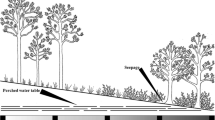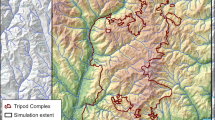Abstract
Fire and grazing are ecological processes that frequently interact to modify landscape patterns of vegetation. There is empirical and theoretical evidence that response of herbivores to heterogeneity is scale-dependent however the relationship between fire and scale of heterogeneity is not well defined. We examined the relationship between fire behavior and spatial scale (i.e., patch grain) of fuel heterogeneity. We created four heterogeneous landscapes modeled after those created by a fire–grazing interaction that differed in grain size of fuel patches. Fire spread was simulated through each model landscape from 80 independent, randomly located ignition points. Burn area, burn shape complexity and the proportion of area burnt by different fire types (headfire, backfire and flankfire) were all affected by the grain of fuel patch. The area fires burned in heterogeneous landscapes interacted with the fuel load present in the patch where ignition occurred. Burn complexity was greater in landscapes with small patch grain than in landscapes with large patch grain. The proportion of each fire type (backfire, flankfire and headfire) was similar among all landscapes regardless of patch grain but the variance of burned area within each of the three fire types differed among treatments of patch grain. Our landscape fire simulation supports the supposition that feedbacks between landscape patterns and ecological processes are scale-dependent, in this case spatial scale of fuel loading altering fire spread through the landscape.




Similar content being viewed by others
References
Adler PB, Raff DA, Lauenroth WK (2001) The effect of grazing on the spatial heterogeneity of vegetation. Oecologia 128:465–479
Ansley RJ, Jones DL, Tunnell TR, Kramp BA, Jacoby PW (1998) Honey mesquite canopy responses to single winter fires: relation to herbaceous fuel, weather and fire temperature. Int J Wildland Fire 8:241–252
Archibald S, Bond WJ (2004) Grazer movements: spatial and temporal responses to burning in a tall-grass African savanna. Int J Wildland Fire 13:377–385
Archibald S, Bond WJ, Stock WD, Fairbanks DHK (2005) Shaping the landscape: fire–grazer interactions in an African savanna. Ecol Appl 15:96–109
Bailey DW, Gross JE, Laca EA, Rittenhouse LR, Coughenour MB, Swift DM, Sims PL (1996) Mechanisms that result in large herbivore grazing distribution patterns. J Rangeland Manage 49:386–400
Bessie WC, Johnson EA (1995) The relative importance of fuels and weather on fire behavior in subalpine forests. Ecology 76:747–762
Bidwell TG, Engle DM, Claypool PL (1990) Effects of spring headfires and backfires on tallgrass prairie. J Range Manage 43:209–212
Bidwell TG, Engle DM (1992) Relationship of fire behavior to tallgrass prairie herbage production. J Range Manage 45:579–584
Bond WJ, Archibald S (2003) Confronting complexity: fire policy choices in South African savanna parks. Int J Wildland Fire 12:381–389
Briggs JM, Knapp AK, Brock BL (2002) Expansion of woody plants in tallgrass prairie: a 15-year study of fire and fire–grazing interactions. Am Midl Nat 147:287–294
Catchpole EA, Hatton TJ, Catchpole WR (1989) Fire spread through nonhomogeneous fuel modeled as a Markov process. Ecol Model 48:101–112
Cheney NP, Gould JS, Catchpole WR (1993) The influence of fuel, weather and fire shape variables on fire-spread in grasslands. Int J Wildland Fire 3:31–44
Cheney NP, Gould JS, Catchpole WR (1998) Prediction of fire spread in grasslands. Int J Wildland Fire 8:1–13
Cheney NP, Sullivan A (1997) Grassfires: fuel, weather and fire behaviour. CSIRO Publishing, Collingwood, Victoria, p 19
Cid MS, Brizuela MA (1998) Heterogeneity in tall fescue pastures created and sustained by cattle grazing. J Range Manage 51:644–649
Coppedge BR, Engle DM, Toepfer CS, Shaw JH (1998) Effects of seasonal fire, bison grazing and climatic variation on tallgrass prairie vegetation. Plant Ecol 139:235–246
Coppedge BR, Shaw JH (1998) Bison grazing patterns on seasonally burned tallgrass prairie. J Range Manage 51:258–264
Etzenhouser MJ, Owens MK, Spalinger DE, Murden SB (1998) Foraging behavior of browsing ruminants in a heterogeneous landscape. Landsc Ecol 13:55–64
Finney MA (1998) Fire area simulator-model: development and evaluation. Research Paper RMRS-RP-4. U.S. Department of Agriculture, Forest Service, Missoula, MT, USA, 47 pp
Finney MA (2001) Design of regular landscape fuel treatment patterns for modifying fire growth and behavior. Forest Sci 47:219–228
Frandsen W, Andrews PL (1979) Fire behavior in non-uniform fuels. Research paper INT-232. U.S. Department of Agriculture, Forest Service, Ogden, UT, 34 pp
Fuhlendorf SD, Engle DM (2001) Restoring heterogeneity on rangelands: ecosystem management based on evolutionary grazing patterns. Bioscience 51:625–632
Fuhlendorf SD, Engle DM (2004) Application of the fire–grazing interaction to restore a shifting mosaic on tallgrass prairie. J Appl Ecol 41:604–614
Gibson DJ, Hartnett DC, Merrill GLS (1990) Fire temperature heterogeneity in contrasting fire prone habitats: Kansas tallgrass prairie and Florida sandhill. Bull Torrey Bot Club 117:349–356
Hargrove WW, Gardner RH, Turner MG, Romme WH, Despain DG (2000) Simulating fire patterns in heterogeneous landscapes. Ecol Model 135:243–263
Hobbs NT, Schimel DS, Owensby CE, Ojima DS (1991) Fire and grazing in the tallgrass prairie: contingent effects on nitrogen budgets. Ecology 72:1374–1382
Hobbs NT (1999) Responses of large herbivores to spatial heterogeneity in ecosystems. In: Jung HJG, Fahey GC (eds) Nutritional ecology of herbivores: proceedings of the 5th international symposium on the nutrition of herbivores. American Society of Animal Science, Savory IL, pp 97–129
Hunsaker CT, Oneill RV, Jackson BL, Timmins SP, Levine DA, Norton DJ (1994) Sampling to characterize landscape pattern. Landsc Ecol 9:207–226
Knapp AK, Blair JM, Briggs JM, Collins SL, Hartnett DC, Johnson LC, Towne EG (1999) The keystone role of bison in North American tallgrass prairie. Bioscience 49:39–50
Knight TM, Holt RD (2005) Fire generates spatial gradients in herbivory: an example from a Florida sandhill ecosystem. Ecology 86:587–593
Kupfer JA, Miller JD (2005) Wildfire effects and post-fire responses of an invasive mesquite population: the interactive importance of grazing and non-native herbaceous species invasion. J Biogeogr 32:453–466
Levene H (1960) Robust tests for the equality of variance. In: Oklin I (eds) Contributions to probability and statistics. Stanford University Press, Palo Alto, CA, pp 278–292
McGarigal K, Cushman SA, Neel MC, Ene E (2002) FRAGSTATS: spatial pattern analysis program for categorical maps. Computer software program produced by the authors at the University of Massachusetts, Amherst. Available at the following web site: www.umass.edu/landeco/research/fragstats/fragstats.html
McNaughton SJ (1984) Grazing lawns: animals in herds, plant form, and coevolution. Am Nat 124:863–886
Mermoz M, Kitzberger T, Veblen TT (2005) Landscape influences on occurrence and spread of wildfires in Patagonian forests and shrublands. Ecology 86:2705–2715
Nahmias J, Tephany H, Duarte J, Letaconnoux S (2000) Fire spreading experiments on heterogeneous fuel beds: applications of percolation theory. Can J For Res 30:1318–1328
Peterson GD (2002) Contagious disturbance, ecological memory, and the emergence of landscape pattern. Ecosystems 5:329–338
Price O, Russell-Smith J, Edwards A (2003) Fine-scale patchiness of different fire intensities in sandstone heath vegetation in northern Australia. Int J Wildland Fire 12:227–236
Pyne SJ, Andrews PL, Laven RD (1996) Introduction to wildland fire. John Wiley & Sons Inc., New York, NY, pp 58–63
Richards GD (1990) An elliptical growth model of forest fire fronts and its numerical solution. Int J Numerical Meth Eng. 30:1163–1179
Ring CB, Nicholson RA, Launchbaugh JL (1985) Vegetational traits of patch-grazed rangeland in west-central Kansas, USA. J Range Manage 38:51–55
Rothermel RC (1972) A mathematical model for prediction fire spread in wildland fuel. General technical report INT-115. U.S. Department of Agriculture, Forest Service, Ogden, UT, 40 pp
Rothermel RC (1983) How to predict the spread and intensity of forest and range fires. General technical report INT-143. U.S. Department of Agriculture, Forest Service, Ogden, UT, 161 pp
SAS Institute Inc. (2004) SAS user’s guide, version 9.1. SAS Publishing, Cary, NC
Senft RL, Coughenour MB, Bailey DW, Rittenhouse LR, Sala OE, Swift DM (1987) Large herbivore foraging and ecological hierarchies. Bioscience 37:789–799
Svejcar TJ (1989) Animal performance and diet quality as influenced by burning on tallgrass prairie. J Range Manage 42:11–15
Turner MG (1989) Landscape ecology: the effect of pattern on process. Ann Rev Ecol Syst 20:171–197
Urban DL (2005) Modeling ecological processes across scales. Ecology 86:1996–2006
Van Wagner CE (1973) Height of crown scorch in forest fires. Can J For Res 3:373–378
Wallace LL, Crosthwaite KA (2005) The effect of fire spatial scale on bison grazing intensity. Landsc Ecol 20:337–349
Wallis de Vries MF, Schippers P (1994) Foraging in a landscape mosaic: selection for energy and minerals in free-ranging cattle. Oecologia 100:107–117
Wallis de Vries MF, Laca EA, Demment MW (1999) The importance of scale of patchiness for selectivity in grazing herbivores. Oecologia 121:355–363
Zar JH (1999) Biostatistical analysis. Prentice Hall, Upper Saddle River, NJ
Acknowledgements
The authors thank T.G. Bidwell, D.M. Leslie, and two anonymous reviewers for thoughtful comments on earlier manuscript drafts. M. Payton provided statistical advice. Funding was provided through a grant by the Joint Fire Sciences Program (Grant #201814G905) and by the Oklahoma Agricultural Experiment Station. This article is published with the approval of the Director, Oklahoma Agricultural Experiment Station.
Author information
Authors and Affiliations
Corresponding author
Rights and permissions
About this article
Cite this article
Kerby, J.D., Fuhlendorf, S.D. & Engle, D.M. Landscape heterogeneity and fire behavior: scale-dependent feedback between fire and grazing processes. Landscape Ecol 22, 507–516 (2007). https://doi.org/10.1007/s10980-006-9039-5
Received:
Accepted:
Published:
Issue Date:
DOI: https://doi.org/10.1007/s10980-006-9039-5




